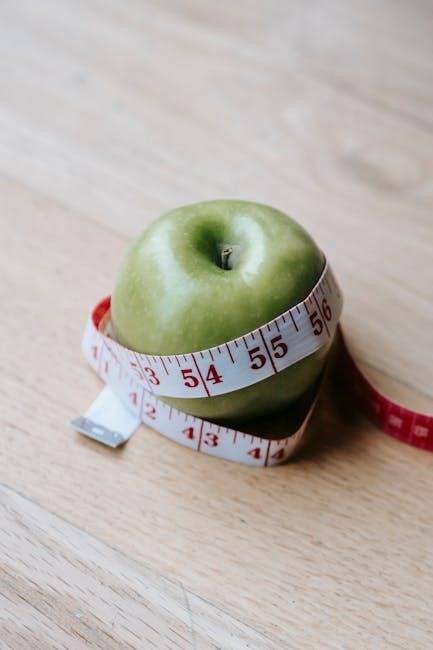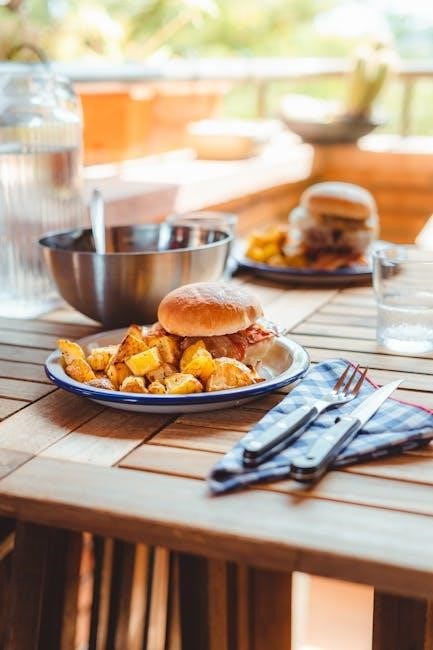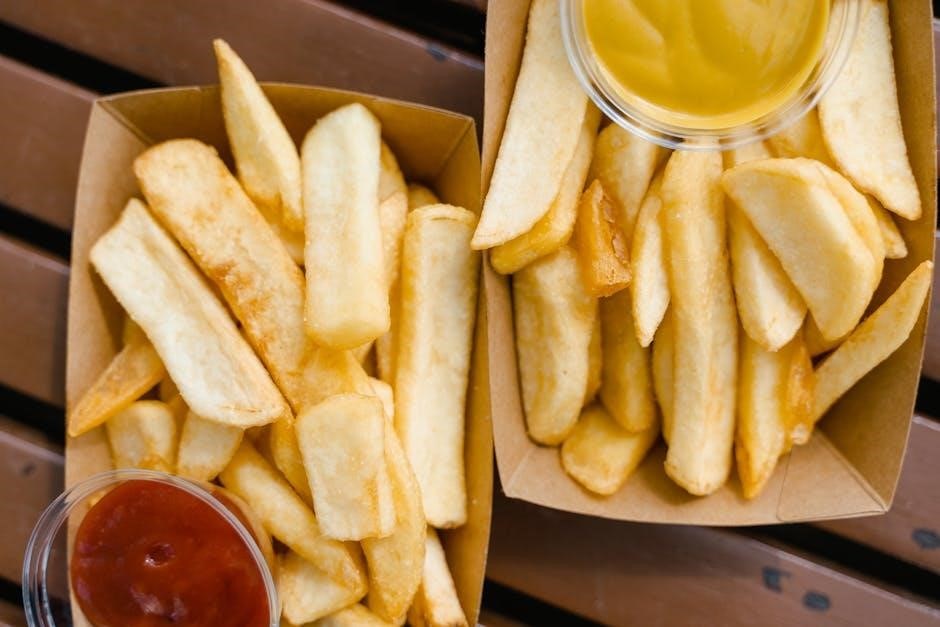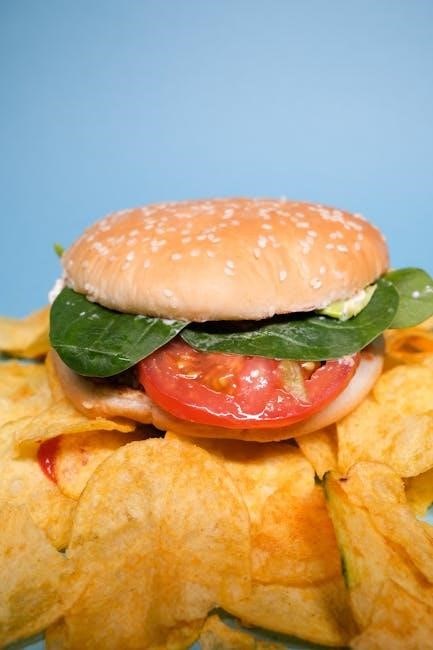A 1600 calorie meal plan is designed for weight loss and maintenance, offering balanced meals and snacks. It’s ideal for those with low to moderate activity levels, promoting healthy eating habits and portion control while ensuring nutritional needs are met. This structured plan helps individuals achieve their weight goals safely and sustainably.
1.1 Overview of the 1600 Calorie Diet
The 1600 calorie diet is a structured meal plan designed for weight loss and maintenance, typically suitable for individuals with low to moderate physical activity. It restricts daily caloric intake to 1,600 calories, balancing macronutrients like protein, carbohydrates, and fats. The plan is divided into meals and snacks, ensuring nutritional balance and portion control. It is adaptable to different lifestyles and dietary preferences, promoting sustainable weight management while maintaining energy levels and overall health.
1.2 Benefits of a 1600 Calorie Meal Plan
A 1600 calorie meal plan offers numerous benefits, including weight loss, improved blood sugar control, and enhanced heart health. It promotes portion control and balanced nutrition, reducing the risk of chronic diseases. The structured approach helps develop healthy eating habits, boosts metabolism, and increases energy levels. Additionally, it supports mental clarity and overall well-being, making it a sustainable choice for long-term health and wellness.
1.3 Who Can Benefit from This Plan?
This plan is ideal for individuals seeking weight loss or maintenance, particularly those with low to moderate physical activity levels. It suits people aiming to reduce body fat while maintaining muscle mass. The structured meals and snacks are beneficial for those who need guidance on portion control and balanced nutrition. Additionally, it’s suitable for individuals with specific dietary needs or health goals, such as improving blood sugar levels or heart health, under medical supervision.
Breakfast Options in the 1600 Calorie Meal Plan
Breakfast options include nutrient-rich choices like scrambled eggs with vegetables, Greek yogurt parfaits, and whole grain toast with avocado, providing a balanced start to the day.
2.1 Scrambled Eggs with Vegetables
Scrambled eggs with vegetables are a protein-packed breakfast option, combining eggs with veggies like spinach, tomatoes, and bell peppers. This dish is low in calories, rich in vitamins, and keeps you full. Pair with whole grain toast for added fiber. Eggs provide essential amino acids, while vegetables add antioxidants and flavor. This meal supports weight loss and energy levels, making it a great start to your day.
2.2 Greek Yogurt Parfait with Berries
Greek yogurt parfait with berries is a delicious and nutritious breakfast option. Layer non-fat Greek yogurt with fresh or frozen berries like blueberries, strawberries, or raspberries. Add a sprinkle of granola for crunch and fiber. This meal is high in protein, low in calories, and rich in antioxidants from the berries. It keeps you full and provides a boost of energy, making it an excellent choice for a healthy start to your day.
2.3 Whole Grain Toast with Avocado
Whole grain toast topped with mashed avocado is a nutrient-rich breakfast option. The healthy fats in avocado provide sustained energy, while the whole grain toast offers fiber and nutrients. Sprinkle with a pinch of salt and pepper for flavor. This dish is simple, satisfying, and keeps you full without exceeding calorie limits. It’s an excellent way to start your day with a balance of healthy fats, carbs, and protein. Portion control ensures it fits perfectly into a 1600-calorie meal plan.
Mid-Morning Snack Ideas
Mid-morning snacks keep energy levels steady and prevent overeating. Opt for nutrient-rich options like fresh fruit, nuts, or a protein smoothie to stay satisfied and focused until lunch.
3.1 Fresh Fruit and Nuts
Fresh fruit and nuts are a nutritious and satisfying mid-morning snack. Pair seasonal fruits like apples or berries with a handful of almonds or walnuts for a boost of vitamins, minerals, and healthy fats. This combination provides natural energy and supports weight management. Opt for unsalted, unsweetened varieties to keep calories in check while enjoying the benefits of fiber and protein.
3.2 Protein Smoothie
A protein smoothie is a quick and nutritious mid-morning snack. Combine Greek yogurt, frozen berries, a handful of spinach, and a splash of almond milk for a refreshing blend. Add a scoop of protein powder for an extra boost. This snack provides sustained energy, supports muscle health, and keeps you full until lunch. It’s customizable and packed with essential nutrients, making it a great option for weight management and overall wellness.

Lunch Recipes for a 1600 Calorie Diet
Discover delicious and nutrient-rich lunch recipes designed to support weight loss. These meals are balanced, flavorful, and tailored to fit within a 1600-calorie daily intake.
4.1 Grilled Chicken Salad
A nutritious and flavorful option, the grilled chicken salad combines lean protein with fresh vegetables. Made with grilled chicken breast, mixed greens, cherry tomatoes, cucumber, and a light vinaigrette, this dish is both satisfying and healthy. It provides approximately 350 calories, along with essential vitamins and minerals. This recipe is ideal for a 1600-calorie diet, supporting weight loss while keeping you energized throughout the day.
4.2 Quinoa Bowl with Vegetables
A nutritious and vibrant option, the quinoa bowl is packed with roasted vegetables like sweet potatoes, Brussels sprouts, and red onions. Topped with a drizzle of lemon-tahini dressing, this dish is both flavorful and healthy. Quinoa provides a complete protein and fiber, while the vegetables add vitamins and minerals. This recipe contributes approximately 400 calories to your daily intake, making it an excellent choice for a balanced and satisfying lunch within the 1600-calorie meal plan.
4.3 Whole Grain Wraps with Lean Turkey
This recipe features whole grain wraps filled with lean turkey breast, crisp lettuce, juicy tomatoes, and sliced cucumbers. A light spread of low-fat mayo or mustard adds flavor. Pair it with a side of baby carrots for added fiber and nutrients. This meal totals approximately 350 calories, making it a protein-rich and satisfying option for lunch within the 1600-calorie plan. It’s also easy to prepare and customizable with your favorite vegetables.

Afternoon Snack Options
Healthy snacks like veggie sticks with hummus or hard-boiled eggs provide a nutrient-dense boost. These options curb hunger and support weight loss while keeping you energized.
5.1 Veggie Sticks with Hummus
Veggie sticks with hummus make a nutritious and filling snack. Carrot, celery, and cucumber sticks provide essential vitamins and fiber, while hummus offers protein and healthy fats. This combination keeps energy levels steady without excess calories, making it a perfect choice for a 1600-calorie meal plan. It’s also easy to prepare and portable, ensuring you stay on track with your weight loss goals throughout the day.
5.2 Hard-Boiled Eggs
Hard-boiled eggs are a convenient and protein-rich snack, perfect for a 1600-calorie meal plan. Each large egg contains about 78 calories and 6 grams of protein, making them an excellent choice for satiety. They are also low in carbs and rich in essential nutrients like vitamin D and choline. Boil a batch in advance for an easy, portable snack that supports weight loss and energy balance without exceeding your daily calorie goals.

Dinner Ideas for Weight Loss
Delicious and balanced dinner options like baked salmon, lentil soup, or grilled shrimp with brown rice offer protein-rich, calorie-conscious meals that support weight loss and satisfaction.
6.1 Baked Salmon with Steamed Vegetables
Baked salmon with steamed vegetables is a nutritious and flavorful dinner option, fitting perfectly into a 1600-calorie meal plan. Salmon provides lean protein and omega-3 fatty acids, while steamed vegetables like broccoli, carrots, and green beans add fiber and vitamins. Season the salmon with herbs and lemon for enhanced taste. This meal is low in calories but high in satisfaction, making it ideal for weight loss and overall health. Pair with a side of quinoa or brown rice for added sustenance.
6.2 Lentil Soup with a Side Salad
Lentil soup with a side salad is a nutrient-packed dinner option, ideal for a 1600-calorie meal plan. Lentils are rich in plant-based protein and fiber, promoting satiety and digestion. Pair cooked lentils with diced vegetables like carrots, celery, and onions, seasoned with herbs and a touch of garlic. Serve with a fresh side salad tossed in a light vinaigrette for added vitamins and crunch. This meal is hearty, flavorful, and perfectly balanced for weight loss and overall health.
6.3 Grilled Shrimp with Brown Rice
Grilled shrimp with brown rice is a delicious and nutritious dinner option for a 1600-calorie meal plan. Shrimp provides lean protein, while brown rice offers complex carbohydrates and fiber. Season shrimp with herbs like garlic, paprika, and lemon zest for flavor. Pair with steamed vegetables like asparagus or broccoli for added vitamins. This meal is low in calories, rich in nutrients, and supports weight loss while keeping you satisfied and energized.

Dessert Options Under 150 Calories
Indulge in guilt-free treats like dark chocolate squares or fresh fruit salads. These desserts are low in calories, rich in flavor, and perfect for satisfying sweet cravings.
7.1 Dark Chocolate Square
A single square of dark chocolate (70% cocoa or higher) is a delicious and satisfying dessert under 150 calories. Rich in antioxidants, it offers a guilt-free treat option. Portion control is key, making it an ideal choice for those seeking indulgence without overstepping calorie limits. Pair it with a cup of herbal tea for a soothing end to your meal. This option aligns perfectly with the 1600 calorie meal plan, providing a sweet escape while maintaining nutritional balance.
7.2 Fresh Fruit Salad
A fresh fruit salad is a light and refreshing dessert option, typically under 150 calories. Mixing seasonal fruits like strawberries, blueberries, kiwi, and pineapple creates a vibrant and nutritious treat. This option is low in calories but rich in vitamins, fiber, and antioxidants. You can add a splash of lemon juice or a drizzle of honey for extra flavor. It’s a perfect way to satisfy your sweet tooth while staying within your daily calorie goals.

Tips for Customizing the Meal Plan
Understand your preferences and dietary needs. Swap protein sources, adjust portion sizes, and incorporate favorite recipes while maintaining calorie and nutrient balance for a personalized approach.
8.1 Swapping Protein Sources
Customize your diet by swapping protein sources to keep meals interesting. Replace grilled chicken with lean turkey, tofu, or fish. For vegetarians, options like lentils, beans, or tempeh are excellent alternatives. Ensure each substitute provides similar nutritional value to maintain balance. This flexibility allows you to tailor meals to your preferences while staying within the 1600-calorie framework and achieving your weight goals effectively.
8.2 Adjusting Portion Sizes
Portion control is key to staying within the 1600-calorie limit. Measure ingredients to ensure accurate servings. Use smaller plates to visually manage portions. If a recipe serves four, divide it evenly to avoid overeating. Adjust quantities based on hunger and activity levels, but maintain the balance of protein, carbs, and fats. Consistency in portion sizes helps sustain weight loss and prevents calorie overload, keeping your diet on track and aligned with your goals.

Grocery List for the 1600 Calorie Meal Plan
Stock your pantry with lean proteins, whole grains, and fresh vegetables. Include items like chicken breast, tofu, quinoa, brown rice, oats, spinach, broccoli, bell peppers, apples, berries, Greek yogurt, and almonds. Don’t forget healthy fats like olive oil and avocado. Incorporate low-calorie snacks such as hummus, hard-boiled eggs, and dark chocolate. Fresh herbs and spices add flavor without extra calories. This list ensures variety and nutritional balance while staying within the 1600-calorie framework.
Health Considerations and Safety
Ensure adequate nutrition by tailoring the plan to individual needs. Monitor health markers and adjust as necessary to maintain overall well-being while following the 1600-calorie diet.
10.1 Consulting a Healthcare Provider
Consulting a healthcare provider before starting a 1600-calorie meal plan is crucial, especially for individuals with medical conditions or dietary restrictions. They can assess your health status, ensure the plan is safe, and provide personalized recommendations. This step helps prevent potential health risks and ensures the plan aligns with your specific needs, promoting sustainable and healthy weight loss.
10.2 Ensuring Nutritional Balance
Ensuring nutritional balance on a 1600-calorie meal plan requires careful planning to meet daily dietary needs. Incorporate a variety of protein sources, whole grains, vegetables, and healthy fats. Portion control and food diversity are key to avoiding nutrient deficiencies. Regularly reviewing your meal plan with a dietitian can help maintain optimal nutrition and support overall health while promoting weight loss goals effectively.

Leave a Reply
You must be logged in to post a comment.